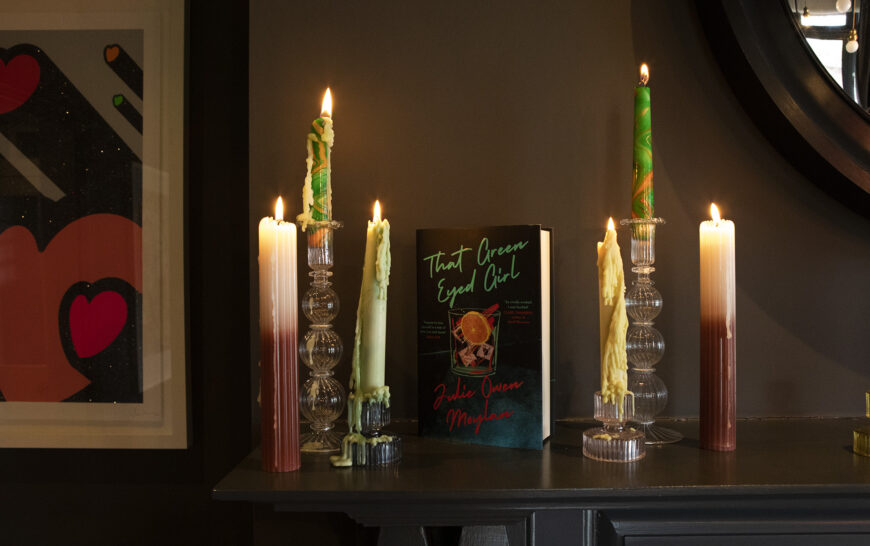
This article is a guest post written by Julie Owen Moylan
When I first came up with the idea for That Green Eyed Girl, I knew there was only one city that I wanted to set it in. A place so full of stories that my novel of complicated women trying to overcome their circumstances would fit quite beautifully. It also happened to be a city that I fell in love with from the moment I arrived.
The first time I went to New York, I was young and broke. Having scraped enough money together for the flight, I could only afford a dorm bunk at the local youth hostel to sleep in. I’d had a long travelling day and decided to splash out on a cab, partly for the thrill of driving in one of the yellow taxis I’d watched people hailing on the movie screen since I was a kid.
As we pulled away from the airport terminal, I noticed the taxi driver glancing in his rear-view mirror at me. Being a young woman travelling alone I was immediately on alert but eventually the driver spoke, ‘This your first time in New York?’ he said, while continuing to examine me via the rear-view mirror. ‘Yes,’ I replied somewhat nervously. He nodded, ‘You on your own?’ He chewed on his lip for a beat while I wondered what the correct answer might be in this situation. He seemed like an okay guy though so I explained that I was backpacking across the USA and New York was my first stop. My friendly taxi driver slapped his hand on the steering wheel and announced, ‘Lady, you’re lucky you got me. 28 years I’ve been driving this cab. Here’s what we’ll do…’
My taxi driver gave me a guided tour of New York driving me around and pointing out the sights or what used to be in that spot. Julie Owen Moylan
It’s a flat fare from JFK airport to anywhere in the city so it doesn’t matter which route you take or how long the journey. My taxi driver gave me a guided tour of New York driving me around and pointing out the sights or what used to be in that spot. He told me stories of growing up in the city and our tour culminated with him driving through Harlem and pulling up outside the famous Apollo theatre. As we sat there in the cab, he reeled off the names of legends who had played there as if he was sitting in one of those seats and watching them perform. It was the most magical welcome to any city that I’ve ever had and the beginning of a long passionate love affair with New York.
I have always been fascinated with the concept of time passing in cities. The idea of so many people gathered together, the history of those houses or apartments. So many stories of ordinary people walking those same streets and living in the same buildings. If only the walls could talk, I used to think and that sparked the idea for this book.
What if I told the story of one apartment over a twenty-year period?
One of the things I’ve noticed about the way we all talk about cities is that it depends what age you are. Some of the buildings we might think of as new or having only been there ‘five minutes’ are already old to younger people. In the city where I live, my grandmother used to give directions often using place names that were no longer there. I find myself looking at brand new buildings and remembering what was there before, the nightclub I used to dance the night away in, the cinema I spent every Saturday morning in as a child. I don’t see the anonymous office block or flats that have replaced those things, because cities are made up of our memories and in that way, we all live with different time periods surrounding us even though we all exist at the same time.
The city of 1975 was very different to the more glamorous 1950s and I wanted to convey both eras on the page.Julie Owen Moylan
The next stage of planning my novel was to choose which time periods I wanted to set the story in. I went for the 1970s and the 1950s because they felt like two completely different types of New York stories. The city of 1975 was very different to the more glamorous 1950s and I wanted to convey both eras on the page. I began with Ava who is almost sixteen at the start of the book and lives in the city that is falling apart. It’s dirty, crumbling, garbage strewn and on the verge of bankruptcy. Everything has an air of grimy reality about it. To reflect what’s going on in the city, I wrote a character who is young but weighed down by a family that’s falling apart. Poor Ava has very few adults to turn to and so she becomes obsessed with finding out what happened to the couple who lived in that same apartment twenty years earlier. To contrast that more dangerous and crumbling period in New York’s history, I imagined glamour, smoky jazz filled clubs, cocktail bars and the kind of life my characters, Dovie and Gillian, would have lived back in the 1950s, while trying to hide their secret life and love from everyone.
By setting the novel over a long hot summer I wanted New York to appear as an extra character in the book. I wanted readers to feel the unrelenting heat in a world with no air conditioning, to smell the garbage on the streets or sense how lonely people can be even when they are surrounded by millions of other people. I wanted readers to be able to step into the world of both 1970s and 1950s New York and to briefly inhabit other women’s lives.
Some of my favourite old movies start with the camera showing us all those New York buildings that are so familiar to us, and then the camera will zoom right in to one apartment, to one window, and we will know that this is just one story out of millions that could be told. That’s what I wanted for That Green Eyed Girl and so I began with young Ava standing at her kitchen window while outside on the streets, people going about their regular business. Our story begins…
Julie Owen Moylan
My love affair with this city has lasted over many years and multiple visits but I will always be grateful to that taxi driver for giving me a New York story I’ll never forget.





